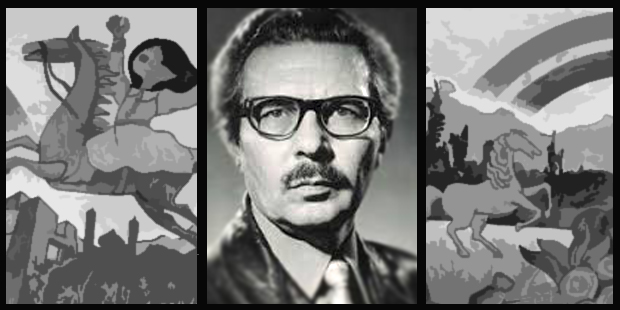
It was that time of the year again; the time that the scent of hyacinths fuses with the smell of vinegar, and the goldfish bounces in its glass jar surrounded by glittering coins and dyed eggs*; the time that a child hears nothing but the singing birds, looks for nothing but the pink blossoms on brown branches, and awaits nothing but Nowruz**, the first day of spring and the Iranian new year.
It was at that time of the year that I got The Rainbow (رنگین کمون), an illustrated book with songs for children by Samin Baghcheban, as my New Year gift. It was an ideal gift for a child at my age for whom opening a colorful book and listening to its songs was like entering a magic closet which opened to the realm of imagination. However, I cannot tell that The Rainbow, with all its inspiring tunes and vivid illustrations, did entirely belong to the world of children. It was rather a threshold through which a child began to observe and taste the complexity of adulthood. For me, It was with the song “Nowruz is on the way” (نوروز تو راهه) that I learned how to exist in nature; with “Dear Doll” (عروسک جون) that I got a sense of being deeply in love and drifting through all the euphoria and worries it generates; or it was with “The Cat Who’s a Mother” (گربه ای که مادره) that I imagined the wild passion of caring for another human being. The Rainbow was not only a contribution to children’s literature but also was a representation of the feelings and instincts that shape an adult. In this case, the sharp contours and the mature color scheme of Parviz Kalantari’s illustration together with Baghcheban’s Orchestral composition for his songs implied that the audience of Rangin kamoon was beyond children and somehow ageless.
Samin Baghcheban, the Iranian musician, composer, author, poet, and translator, was born in 1925 in Tabriz. He was the son of Jabbar Baghcheban, a leading Iranian educator, who was the founder of the first Iranian kindergarten for children with hearing loss and the inventor of the Persian cued speech. He also wrote songs and plays for children. Samin spent his childhood in Shiraz and then went to Tehran to study music. He wanted to play the piano but his family couldn’t afford one. So he chose the oboe, the only instrument he could borrow from the Tehran Conservatory of Music. In 1944, he was awarded a scholarship to study music composition in Ankara State Conservatory where he met Evelyn, a Turkish mezzo-soprano opera singer. They got married, returned to Iran in 1949, and started teaching at the Tehran Conservatory of Music. Samin taught composition and counterpoint, and Evelyn established the first technical course on singing and piano and taught well-known tenor singers like Mohammad Nouri and Hossein Sarshar and vocalists such as Pari Zanganeh and Soudabeh Tajbakhsh. She also launched Tehran National Choir, Tehran Conservatory of Music Choir, Farrah Pahlavi Choir, and helped launch the Roudaki Hall.
In 1984, a few years after the Iranian revolution of 1979 and due to the cultural restrictions of the post-revolution era, Samin and his family moved to Turkey. There, he only composed a few new pieces and continued the rest of his life with the agony of being away from his homeland. He died on 19 March 2008 in Istanbul just as Nowruz, the day which he loved childishly and praised dearly, was coming: “On every Nowruz, I become a kid again; a four or five-year-old boy. My eyes, ears, nose, mouth, and skin all turn into a kid. Even my voice sounds like a kid”.
During his career, especially before the revolution, Samin composed many orchestral pieces on Iranian folklore and mythology. His passion for the folk music of Iran made him an expert to combine his knowledge of classical music with his legacy of Iranian music. Although known as an influential musician, it would be short-sighted to dismiss his influential role in the realm of literature. He made a great contribution to children’s literature through the spirited and inspiring songs he created for them. In addition, he introduced some of the most prominent Turkish literary figures to Iranians through translating books by writers Yaşar Kemal and Aziz Nesin, and poet Nazim Hikmet.
Now, it is that time of the year again; the best time to listen to “Nowruz is on the way” (نوروز تو راهه) and to remember Samin Baghcheban.
LISTEN TO “NOWRUZ IS ON ITS WAY”
——————————————————————————————————-
*These elements refer to the elements of Haft-Sin (the Seven S’s). Haft-Seen is a traditional table setting for Nowruz adorned by seven items all starting with the letter S and each symbolizing a concept: Sabzeh (wheat grass), Samanou (sweet pudding made with wheat), Senjed (a kind of a dried fruit), Sib (apple), Sir (garlic), Somaq (sumac), Serkeh (vinegar). It also includes the goldfish, dyed eggs, coins, candles, a mirror, the Qur’an or/and the Divan of Hafez.
**Nowruz, meaning “New Day”, is a traditional ancient festival which celebrates the starts of the Persian New Year in the Persian Solar Hijri calendar on the first day of spring. It is on the day of the astronomical Northward equinox, which usually occurs on March 21 or the previous/following day depending on where it is observed. The moment the Sun crosses the celestial equator and equalizes night and day is calculated exactly every year and families gather together to celebrate the moment and observe the rituals.
Biblio Brief
-Compositions/Songs
- The Rainbow (رنگین کمون), Mahoor, Tehran.
Rangin Kamoon is a collection of symphonic and choral tunes for children written and composed by Samin Baghcheban and illustrated by Parviz Kalantari. It was performed by the members of ORF Symphony Orchestra (Vienna Radio Symphony Orchestra) with Thomas Christian David as the conductor, Mitra choir (composed of the orphan students of Farah school), Evelyn Baghcheban as the mezzo-soprano and Behjat Ghasri as the soprano singers.
Samin has dedicated the book to his father, Jabbar, who “has taught him the first poems and songs, bought him a drawing notebook and colored pencils, and helped him draw the first pictures of a gazelle, a ship, a crow, the Sun, and people”.
Samin was working on the second part of The Rainbow, which was left unfinished due to his death.
- Nowruzes and Kites (نوروزها و بادبادک ها), Kanoon-e- Parvaresh, Tehran.
- Zal & Roudabeh (زال و رودابه)
It is the first stage performance and one of the most well-known pieces by Samin which was performed at the opening ceremony of Roudaki Hall (Vahdat Hall) in Tehran in 1967.
- Sholeyl (شلیل): Inspired by a Bakhtiari folk music, a piece for strings
- The Ruin (ویرانه): A folk piece for choir, harp, and strings
- Boomi-Var Suite: An orchestral folk piece
- The Cedar Tree (درخت سرو): A choral, orchestral folk piece
- Matal: A piece for choir, piano, and percussion
- The Three Colored Flame (شعله سه رنگ): A chant for choir
- Do Zolfoonet, Tanha, To Ra Mikham, Del, Tar Gosaste, Gol- e- Gandom: Six singing pieces
- People (مردم) Suite: An orchestral piece
-Novel
- Snapshots of My father (چهره هایی از پدرم), Ghatreh, Tehran, 2003.
The book is a memoir of Samin’s father, Jabbar, in which he portrays his challenges and hardships as a teacher, his passion for his students, his spirited view of life, and his influential role as a father.
-Translations
- Three Poetry Collections (سه منظومه), Nazim Hikmet, Amir-Kabir, Tehran, 1973.
- Farhad, Shirin, Lady Mehmeneh, and the Water from Bisotun Mountain’s Spring (فرهاد، شیرین، مهمنه بانو و آب سرچشمه کوه بیستون), Nazim Hikmet, Sepehr, Tehran, 1967.
- The Lamb Who Turned into a Wolf (بره ای که گرگ شد), Aziz Nesin, Hamgam, Mashhad.
- Should I Talk or not? (حرف بزنم یا نزنم؟), Aziz Nesin, Hamgam, Tehran.
- Beware of the the Animal! (حیوان را دست کم نگیر), Aziz Nesin, Amir- Kabir, Tehran, 1978.
- Towards Asfal al-ssafelin (به طرف اسفل السافلین), Aziz Nesin, Hamgam, Mashhad.
- A Lunatic Broke Loose (دیوانه ای گریخت), Aziz Nesin, Tehran.
- My Offspring, Be Humane! (فرزندانم، آدم باشید), Aziz Nesin, Tehran.
- The Jerks (فلان- فلان شده ها), Aziz Nesin, Sepehr, Tehran, 1968.
- The Naughty Fly (مگس آتش پاره), Aziz Nesin, Khooshe, Tehran, 1999.
- Ince Memed (اینجه ممد), Yaşar Kemal, ketabe Zaman, 1974.
- The Man who had forgotten the City (مردی که شهر را فراموش کرده بود), Sait Faik, Negah, Tehran, 2001.




Leave a Reply